SIT340 Research: Web Services, Databases, and Software Development
VerifiedAdded on 2023/06/16
|13
|3733
|370
Report
AI Summary
This survey report delves into the intricate relationship between web services, databases, and software development, highlighting their evolution, challenges, and modern research advancements. It begins by establishing the background of each component, tracing the origins of web services from DARPA's distributed computer systems to the rise of RPC and document-style architectures. The report then explores the historical growth of database technology, from punched card tabulators to the era of big data and cloud computing, while addressing the critical security concerns associated with large-scale data collection. Furthermore, the report discusses the evolution of software development, from early coding languages like FORTRAN and COBOL to modern GUI-based software and mobile applications. It highlights the crucial role of community-based web services and open-access journals like SoftwareX in fostering collaboration and innovation. The report also addresses challenges such as security threats in cloud computing, the complexities of managing big data, and the disadvantages of various software development lifecycle models. Finally, the report examines methods for discovering and selecting appropriate web services, distinguishing between SOAP and RESTful architectures, and emphasizing the importance of quality of service parameters. Desklib provides access to this report and many more resources for students.
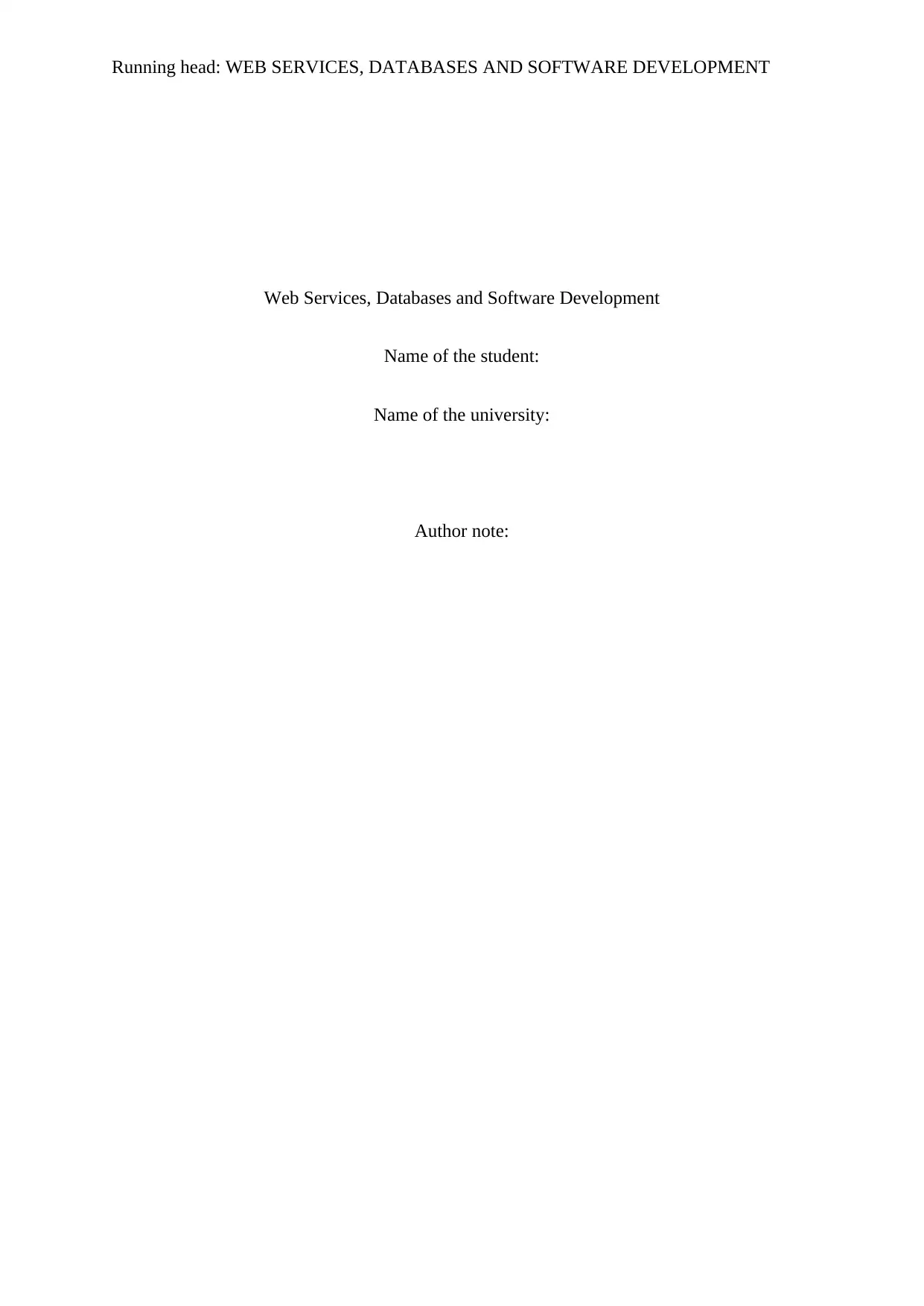
Running head: WEB SERVICES, DATABASES AND SOFTWARE DEVELOPMENT
Web Services, Databases and Software Development
Name of the student:
Name of the university:
Author note:
Web Services, Databases and Software Development
Name of the student:
Name of the university:
Author note:
Paraphrase This Document
Need a fresh take? Get an instant paraphrase of this document with our AI Paraphraser
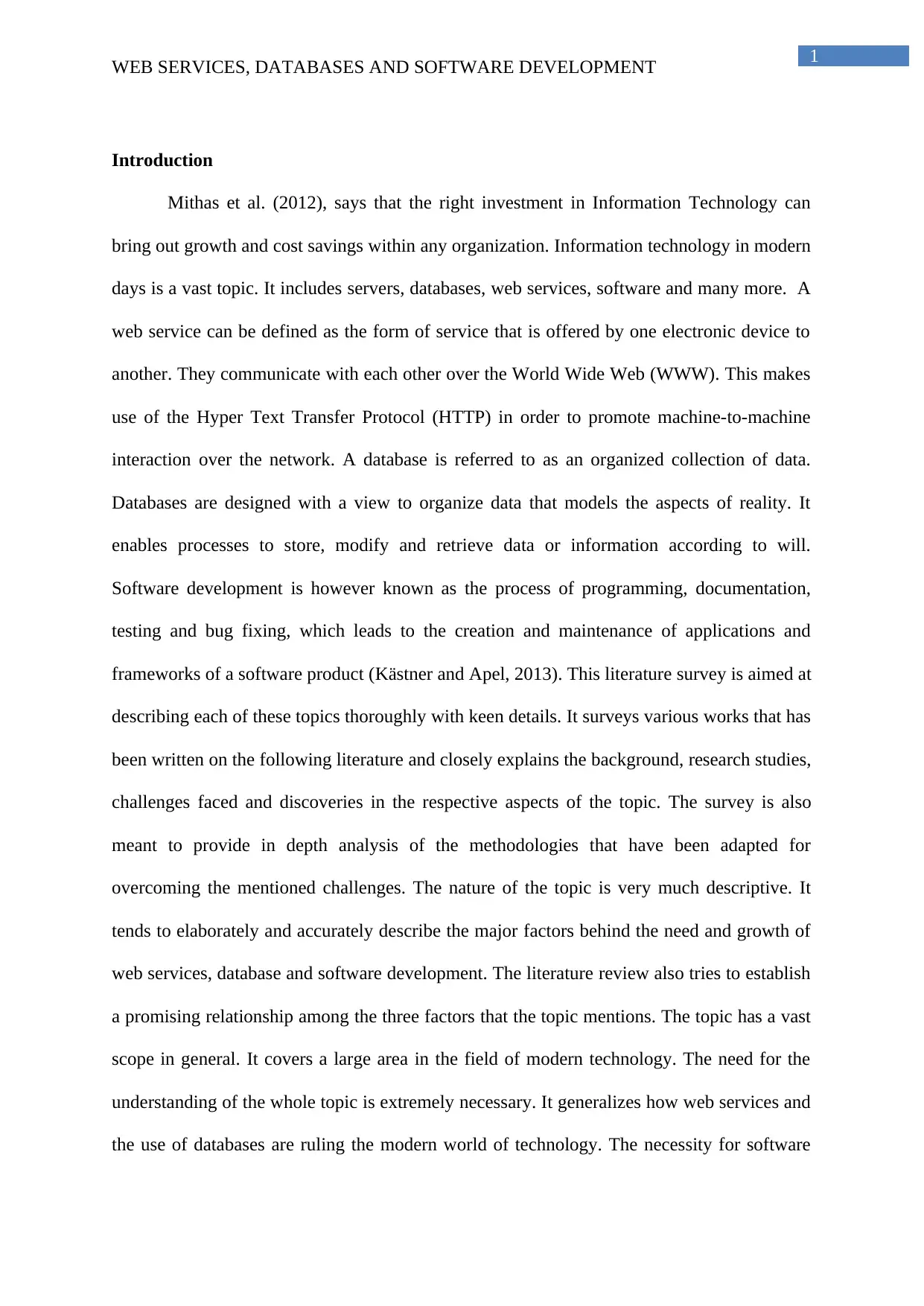
1
WEB SERVICES, DATABASES AND SOFTWARE DEVELOPMENT
Introduction
Mithas et al. (2012), says that the right investment in Information Technology can
bring out growth and cost savings within any organization. Information technology in modern
days is a vast topic. It includes servers, databases, web services, software and many more. A
web service can be defined as the form of service that is offered by one electronic device to
another. They communicate with each other over the World Wide Web (WWW). This makes
use of the Hyper Text Transfer Protocol (HTTP) in order to promote machine-to-machine
interaction over the network. A database is referred to as an organized collection of data.
Databases are designed with a view to organize data that models the aspects of reality. It
enables processes to store, modify and retrieve data or information according to will.
Software development is however known as the process of programming, documentation,
testing and bug fixing, which leads to the creation and maintenance of applications and
frameworks of a software product (Kästner and Apel, 2013). This literature survey is aimed at
describing each of these topics thoroughly with keen details. It surveys various works that has
been written on the following literature and closely explains the background, research studies,
challenges faced and discoveries in the respective aspects of the topic. The survey is also
meant to provide in depth analysis of the methodologies that have been adapted for
overcoming the mentioned challenges. The nature of the topic is very much descriptive. It
tends to elaborately and accurately describe the major factors behind the need and growth of
web services, database and software development. The literature review also tries to establish
a promising relationship among the three factors that the topic mentions. The topic has a vast
scope in general. It covers a large area in the field of modern technology. The need for the
understanding of the whole topic is extremely necessary. It generalizes how web services and
the use of databases are ruling the modern world of technology. The necessity for software
WEB SERVICES, DATABASES AND SOFTWARE DEVELOPMENT
Introduction
Mithas et al. (2012), says that the right investment in Information Technology can
bring out growth and cost savings within any organization. Information technology in modern
days is a vast topic. It includes servers, databases, web services, software and many more. A
web service can be defined as the form of service that is offered by one electronic device to
another. They communicate with each other over the World Wide Web (WWW). This makes
use of the Hyper Text Transfer Protocol (HTTP) in order to promote machine-to-machine
interaction over the network. A database is referred to as an organized collection of data.
Databases are designed with a view to organize data that models the aspects of reality. It
enables processes to store, modify and retrieve data or information according to will.
Software development is however known as the process of programming, documentation,
testing and bug fixing, which leads to the creation and maintenance of applications and
frameworks of a software product (Kästner and Apel, 2013). This literature survey is aimed at
describing each of these topics thoroughly with keen details. It surveys various works that has
been written on the following literature and closely explains the background, research studies,
challenges faced and discoveries in the respective aspects of the topic. The survey is also
meant to provide in depth analysis of the methodologies that have been adapted for
overcoming the mentioned challenges. The nature of the topic is very much descriptive. It
tends to elaborately and accurately describe the major factors behind the need and growth of
web services, database and software development. The literature review also tries to establish
a promising relationship among the three factors that the topic mentions. The topic has a vast
scope in general. It covers a large area in the field of modern technology. The need for the
understanding of the whole topic is extremely necessary. It generalizes how web services and
the use of databases are ruling the modern world of technology. The necessity for software
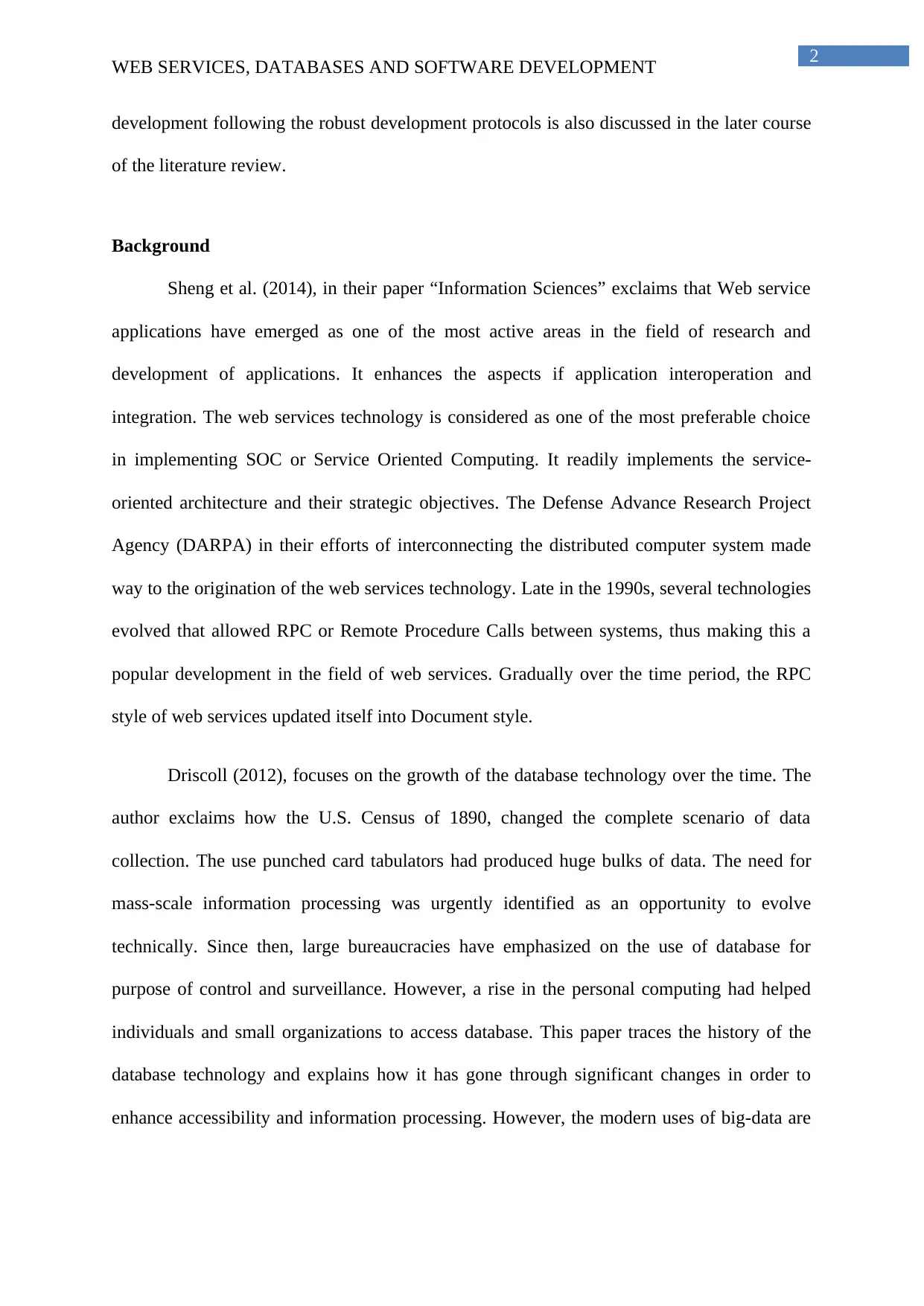
2
WEB SERVICES, DATABASES AND SOFTWARE DEVELOPMENT
development following the robust development protocols is also discussed in the later course
of the literature review.
Background
Sheng et al. (2014), in their paper “Information Sciences” exclaims that Web service
applications have emerged as one of the most active areas in the field of research and
development of applications. It enhances the aspects if application interoperation and
integration. The web services technology is considered as one of the most preferable choice
in implementing SOC or Service Oriented Computing. It readily implements the service-
oriented architecture and their strategic objectives. The Defense Advance Research Project
Agency (DARPA) in their efforts of interconnecting the distributed computer system made
way to the origination of the web services technology. Late in the 1990s, several technologies
evolved that allowed RPC or Remote Procedure Calls between systems, thus making this a
popular development in the field of web services. Gradually over the time period, the RPC
style of web services updated itself into Document style.
Driscoll (2012), focuses on the growth of the database technology over the time. The
author exclaims how the U.S. Census of 1890, changed the complete scenario of data
collection. The use punched card tabulators had produced huge bulks of data. The need for
mass-scale information processing was urgently identified as an opportunity to evolve
technically. Since then, large bureaucracies have emphasized on the use of database for
purpose of control and surveillance. However, a rise in the personal computing had helped
individuals and small organizations to access database. This paper traces the history of the
database technology and explains how it has gone through significant changes in order to
enhance accessibility and information processing. However, the modern uses of big-data are
WEB SERVICES, DATABASES AND SOFTWARE DEVELOPMENT
development following the robust development protocols is also discussed in the later course
of the literature review.
Background
Sheng et al. (2014), in their paper “Information Sciences” exclaims that Web service
applications have emerged as one of the most active areas in the field of research and
development of applications. It enhances the aspects if application interoperation and
integration. The web services technology is considered as one of the most preferable choice
in implementing SOC or Service Oriented Computing. It readily implements the service-
oriented architecture and their strategic objectives. The Defense Advance Research Project
Agency (DARPA) in their efforts of interconnecting the distributed computer system made
way to the origination of the web services technology. Late in the 1990s, several technologies
evolved that allowed RPC or Remote Procedure Calls between systems, thus making this a
popular development in the field of web services. Gradually over the time period, the RPC
style of web services updated itself into Document style.
Driscoll (2012), focuses on the growth of the database technology over the time. The
author exclaims how the U.S. Census of 1890, changed the complete scenario of data
collection. The use punched card tabulators had produced huge bulks of data. The need for
mass-scale information processing was urgently identified as an opportunity to evolve
technically. Since then, large bureaucracies have emphasized on the use of database for
purpose of control and surveillance. However, a rise in the personal computing had helped
individuals and small organizations to access database. This paper traces the history of the
database technology and explains how it has gone through significant changes in order to
enhance accessibility and information processing. However, the modern uses of big-data are
⊘ This is a preview!⊘
Do you want full access?
Subscribe today to unlock all pages.

Trusted by 1+ million students worldwide
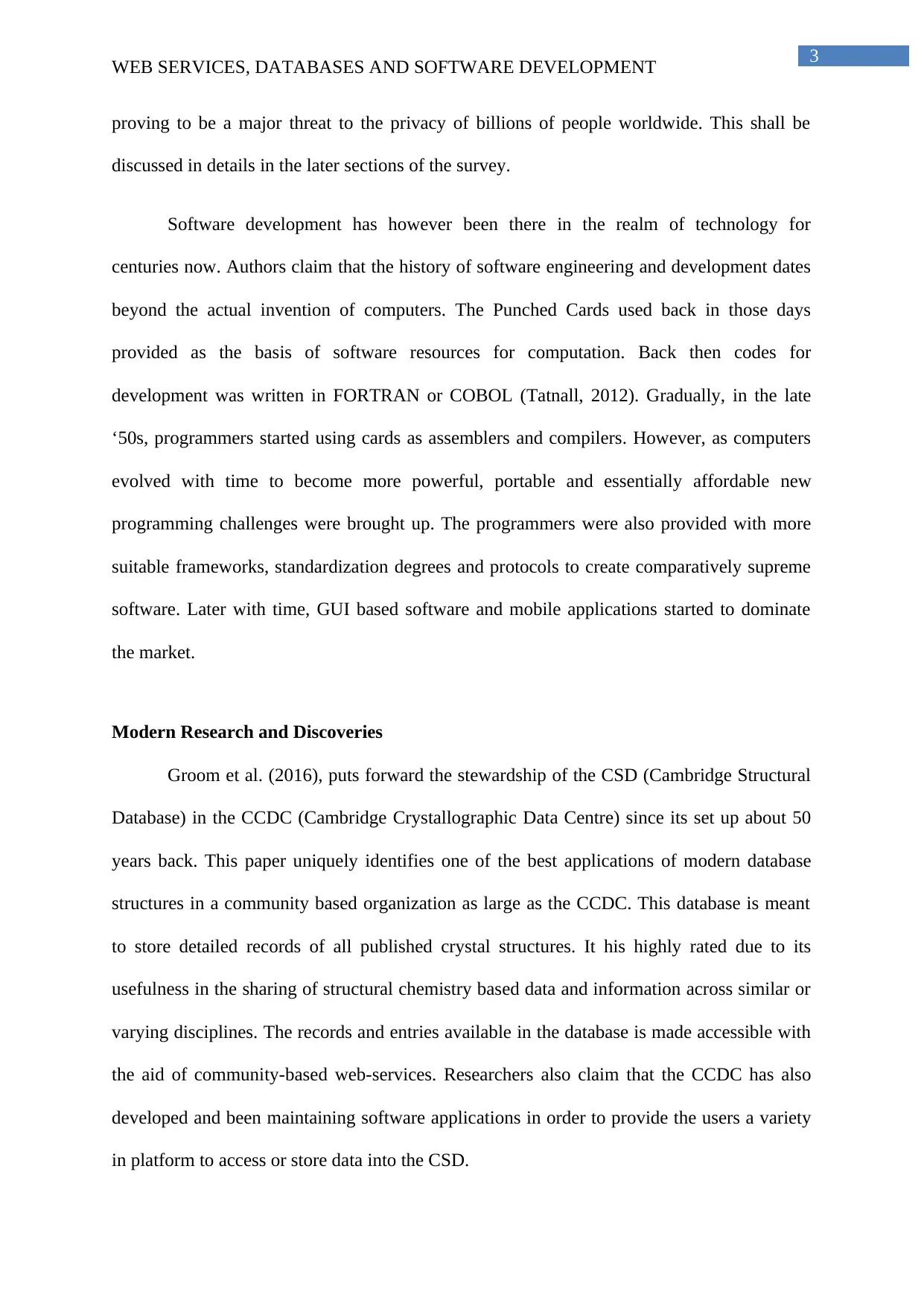
3
WEB SERVICES, DATABASES AND SOFTWARE DEVELOPMENT
proving to be a major threat to the privacy of billions of people worldwide. This shall be
discussed in details in the later sections of the survey.
Software development has however been there in the realm of technology for
centuries now. Authors claim that the history of software engineering and development dates
beyond the actual invention of computers. The Punched Cards used back in those days
provided as the basis of software resources for computation. Back then codes for
development was written in FORTRAN or COBOL (Tatnall, 2012). Gradually, in the late
‘50s, programmers started using cards as assemblers and compilers. However, as computers
evolved with time to become more powerful, portable and essentially affordable new
programming challenges were brought up. The programmers were also provided with more
suitable frameworks, standardization degrees and protocols to create comparatively supreme
software. Later with time, GUI based software and mobile applications started to dominate
the market.
Modern Research and Discoveries
Groom et al. (2016), puts forward the stewardship of the CSD (Cambridge Structural
Database) in the CCDC (Cambridge Crystallographic Data Centre) since its set up about 50
years back. This paper uniquely identifies one of the best applications of modern database
structures in a community based organization as large as the CCDC. This database is meant
to store detailed records of all published crystal structures. It his highly rated due to its
usefulness in the sharing of structural chemistry based data and information across similar or
varying disciplines. The records and entries available in the database is made accessible with
the aid of community-based web-services. Researchers also claim that the CCDC has also
developed and been maintaining software applications in order to provide the users a variety
in platform to access or store data into the CSD.
WEB SERVICES, DATABASES AND SOFTWARE DEVELOPMENT
proving to be a major threat to the privacy of billions of people worldwide. This shall be
discussed in details in the later sections of the survey.
Software development has however been there in the realm of technology for
centuries now. Authors claim that the history of software engineering and development dates
beyond the actual invention of computers. The Punched Cards used back in those days
provided as the basis of software resources for computation. Back then codes for
development was written in FORTRAN or COBOL (Tatnall, 2012). Gradually, in the late
‘50s, programmers started using cards as assemblers and compilers. However, as computers
evolved with time to become more powerful, portable and essentially affordable new
programming challenges were brought up. The programmers were also provided with more
suitable frameworks, standardization degrees and protocols to create comparatively supreme
software. Later with time, GUI based software and mobile applications started to dominate
the market.
Modern Research and Discoveries
Groom et al. (2016), puts forward the stewardship of the CSD (Cambridge Structural
Database) in the CCDC (Cambridge Crystallographic Data Centre) since its set up about 50
years back. This paper uniquely identifies one of the best applications of modern database
structures in a community based organization as large as the CCDC. This database is meant
to store detailed records of all published crystal structures. It his highly rated due to its
usefulness in the sharing of structural chemistry based data and information across similar or
varying disciplines. The records and entries available in the database is made accessible with
the aid of community-based web-services. Researchers also claim that the CCDC has also
developed and been maintaining software applications in order to provide the users a variety
in platform to access or store data into the CSD.
Paraphrase This Document
Need a fresh take? Get an instant paraphrase of this document with our AI Paraphraser
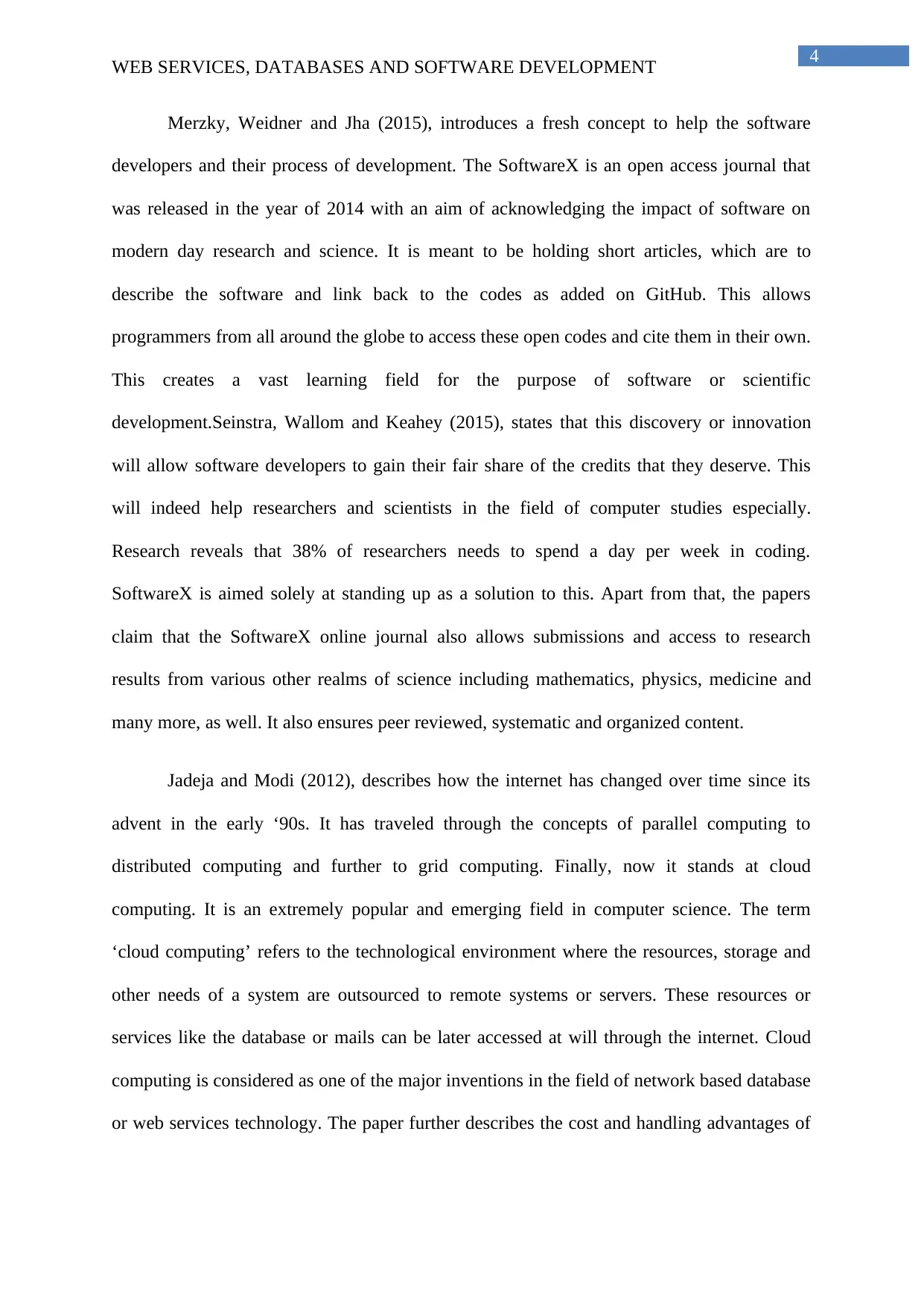
4
WEB SERVICES, DATABASES AND SOFTWARE DEVELOPMENT
Merzky, Weidner and Jha (2015), introduces a fresh concept to help the software
developers and their process of development. The SoftwareX is an open access journal that
was released in the year of 2014 with an aim of acknowledging the impact of software on
modern day research and science. It is meant to be holding short articles, which are to
describe the software and link back to the codes as added on GitHub. This allows
programmers from all around the globe to access these open codes and cite them in their own.
This creates a vast learning field for the purpose of software or scientific
development.Seinstra, Wallom and Keahey (2015), states that this discovery or innovation
will allow software developers to gain their fair share of the credits that they deserve. This
will indeed help researchers and scientists in the field of computer studies especially.
Research reveals that 38% of researchers needs to spend a day per week in coding.
SoftwareX is aimed solely at standing up as a solution to this. Apart from that, the papers
claim that the SoftwareX online journal also allows submissions and access to research
results from various other realms of science including mathematics, physics, medicine and
many more, as well. It also ensures peer reviewed, systematic and organized content.
Jadeja and Modi (2012), describes how the internet has changed over time since its
advent in the early ‘90s. It has traveled through the concepts of parallel computing to
distributed computing and further to grid computing. Finally, now it stands at cloud
computing. It is an extremely popular and emerging field in computer science. The term
‘cloud computing’ refers to the technological environment where the resources, storage and
other needs of a system are outsourced to remote systems or servers. These resources or
services like the database or mails can be later accessed at will through the internet. Cloud
computing is considered as one of the major inventions in the field of network based database
or web services technology. The paper further describes the cost and handling advantages of
WEB SERVICES, DATABASES AND SOFTWARE DEVELOPMENT
Merzky, Weidner and Jha (2015), introduces a fresh concept to help the software
developers and their process of development. The SoftwareX is an open access journal that
was released in the year of 2014 with an aim of acknowledging the impact of software on
modern day research and science. It is meant to be holding short articles, which are to
describe the software and link back to the codes as added on GitHub. This allows
programmers from all around the globe to access these open codes and cite them in their own.
This creates a vast learning field for the purpose of software or scientific
development.Seinstra, Wallom and Keahey (2015), states that this discovery or innovation
will allow software developers to gain their fair share of the credits that they deserve. This
will indeed help researchers and scientists in the field of computer studies especially.
Research reveals that 38% of researchers needs to spend a day per week in coding.
SoftwareX is aimed solely at standing up as a solution to this. Apart from that, the papers
claim that the SoftwareX online journal also allows submissions and access to research
results from various other realms of science including mathematics, physics, medicine and
many more, as well. It also ensures peer reviewed, systematic and organized content.
Jadeja and Modi (2012), describes how the internet has changed over time since its
advent in the early ‘90s. It has traveled through the concepts of parallel computing to
distributed computing and further to grid computing. Finally, now it stands at cloud
computing. It is an extremely popular and emerging field in computer science. The term
‘cloud computing’ refers to the technological environment where the resources, storage and
other needs of a system are outsourced to remote systems or servers. These resources or
services like the database or mails can be later accessed at will through the internet. Cloud
computing is considered as one of the major inventions in the field of network based database
or web services technology. The paper further describes the cost and handling advantages of
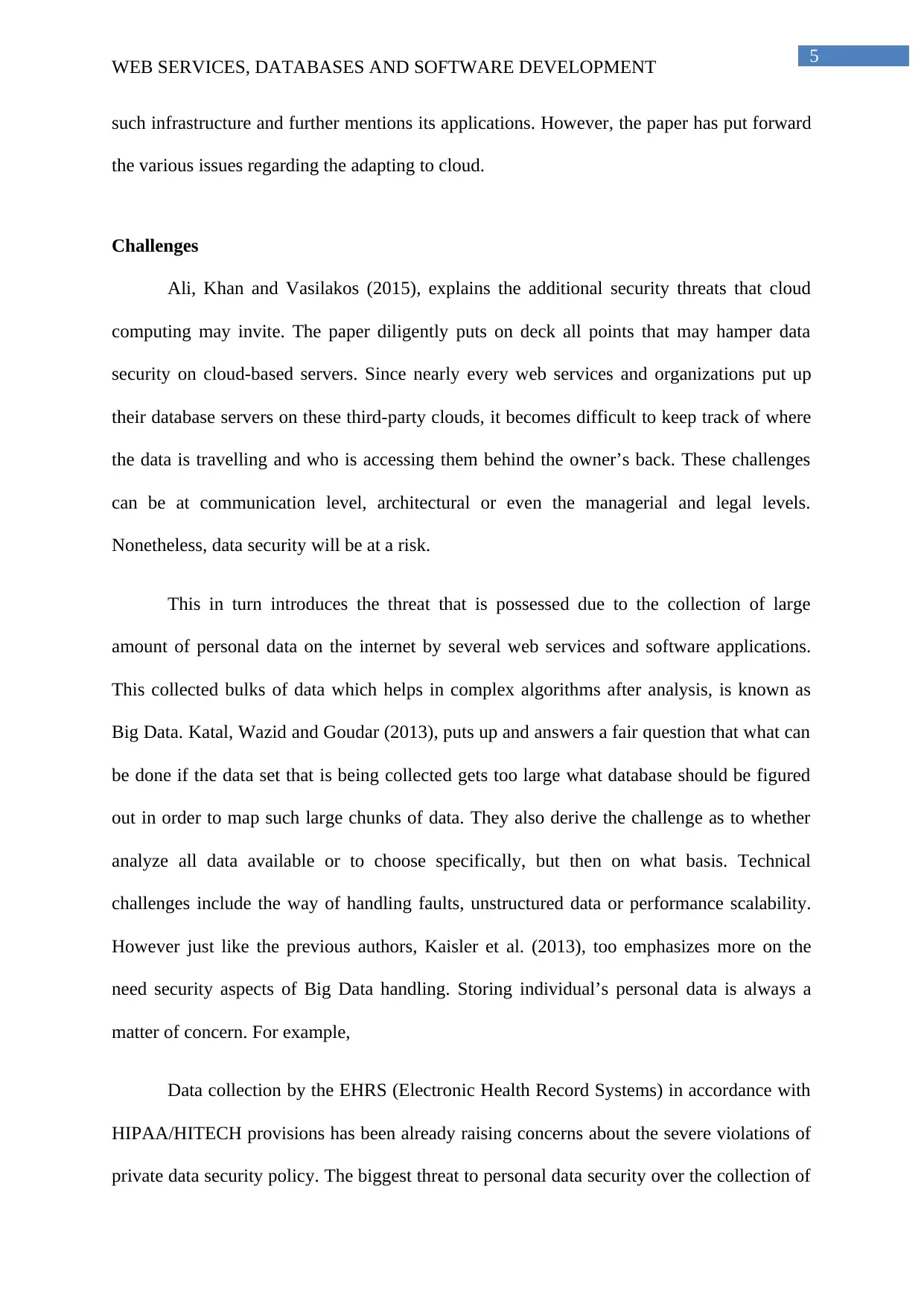
5
WEB SERVICES, DATABASES AND SOFTWARE DEVELOPMENT
such infrastructure and further mentions its applications. However, the paper has put forward
the various issues regarding the adapting to cloud.
Challenges
Ali, Khan and Vasilakos (2015), explains the additional security threats that cloud
computing may invite. The paper diligently puts on deck all points that may hamper data
security on cloud-based servers. Since nearly every web services and organizations put up
their database servers on these third-party clouds, it becomes difficult to keep track of where
the data is travelling and who is accessing them behind the owner’s back. These challenges
can be at communication level, architectural or even the managerial and legal levels.
Nonetheless, data security will be at a risk.
This in turn introduces the threat that is possessed due to the collection of large
amount of personal data on the internet by several web services and software applications.
This collected bulks of data which helps in complex algorithms after analysis, is known as
Big Data. Katal, Wazid and Goudar (2013), puts up and answers a fair question that what can
be done if the data set that is being collected gets too large what database should be figured
out in order to map such large chunks of data. They also derive the challenge as to whether
analyze all data available or to choose specifically, but then on what basis. Technical
challenges include the way of handling faults, unstructured data or performance scalability.
However just like the previous authors, Kaisler et al. (2013), too emphasizes more on the
need security aspects of Big Data handling. Storing individual’s personal data is always a
matter of concern. For example,
Data collection by the EHRS (Electronic Health Record Systems) in accordance with
HIPAA/HITECH provisions has been already raising concerns about the severe violations of
private data security policy. The biggest threat to personal data security over the collection of
WEB SERVICES, DATABASES AND SOFTWARE DEVELOPMENT
such infrastructure and further mentions its applications. However, the paper has put forward
the various issues regarding the adapting to cloud.
Challenges
Ali, Khan and Vasilakos (2015), explains the additional security threats that cloud
computing may invite. The paper diligently puts on deck all points that may hamper data
security on cloud-based servers. Since nearly every web services and organizations put up
their database servers on these third-party clouds, it becomes difficult to keep track of where
the data is travelling and who is accessing them behind the owner’s back. These challenges
can be at communication level, architectural or even the managerial and legal levels.
Nonetheless, data security will be at a risk.
This in turn introduces the threat that is possessed due to the collection of large
amount of personal data on the internet by several web services and software applications.
This collected bulks of data which helps in complex algorithms after analysis, is known as
Big Data. Katal, Wazid and Goudar (2013), puts up and answers a fair question that what can
be done if the data set that is being collected gets too large what database should be figured
out in order to map such large chunks of data. They also derive the challenge as to whether
analyze all data available or to choose specifically, but then on what basis. Technical
challenges include the way of handling faults, unstructured data or performance scalability.
However just like the previous authors, Kaisler et al. (2013), too emphasizes more on the
need security aspects of Big Data handling. Storing individual’s personal data is always a
matter of concern. For example,
Data collection by the EHRS (Electronic Health Record Systems) in accordance with
HIPAA/HITECH provisions has been already raising concerns about the severe violations of
private data security policy. The biggest threat to personal data security over the collection of
⊘ This is a preview!⊘
Do you want full access?
Subscribe today to unlock all pages.

Trusted by 1+ million students worldwide
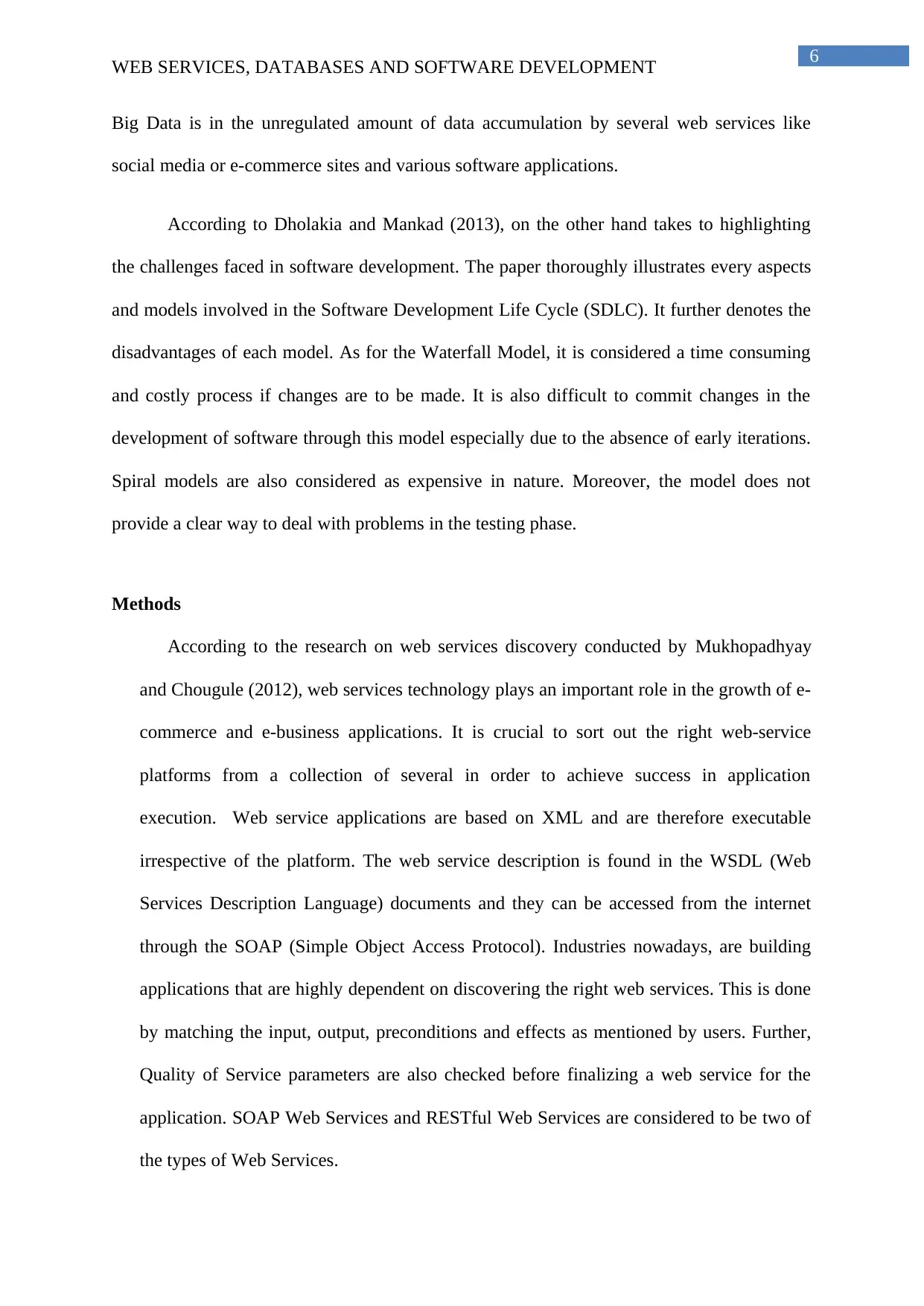
6
WEB SERVICES, DATABASES AND SOFTWARE DEVELOPMENT
Big Data is in the unregulated amount of data accumulation by several web services like
social media or e-commerce sites and various software applications.
According to Dholakia and Mankad (2013), on the other hand takes to highlighting
the challenges faced in software development. The paper thoroughly illustrates every aspects
and models involved in the Software Development Life Cycle (SDLC). It further denotes the
disadvantages of each model. As for the Waterfall Model, it is considered a time consuming
and costly process if changes are to be made. It is also difficult to commit changes in the
development of software through this model especially due to the absence of early iterations.
Spiral models are also considered as expensive in nature. Moreover, the model does not
provide a clear way to deal with problems in the testing phase.
Methods
According to the research on web services discovery conducted by Mukhopadhyay
and Chougule (2012), web services technology plays an important role in the growth of e-
commerce and e-business applications. It is crucial to sort out the right web-service
platforms from a collection of several in order to achieve success in application
execution. Web service applications are based on XML and are therefore executable
irrespective of the platform. The web service description is found in the WSDL (Web
Services Description Language) documents and they can be accessed from the internet
through the SOAP (Simple Object Access Protocol). Industries nowadays, are building
applications that are highly dependent on discovering the right web services. This is done
by matching the input, output, preconditions and effects as mentioned by users. Further,
Quality of Service parameters are also checked before finalizing a web service for the
application. SOAP Web Services and RESTful Web Services are considered to be two of
the types of Web Services.
WEB SERVICES, DATABASES AND SOFTWARE DEVELOPMENT
Big Data is in the unregulated amount of data accumulation by several web services like
social media or e-commerce sites and various software applications.
According to Dholakia and Mankad (2013), on the other hand takes to highlighting
the challenges faced in software development. The paper thoroughly illustrates every aspects
and models involved in the Software Development Life Cycle (SDLC). It further denotes the
disadvantages of each model. As for the Waterfall Model, it is considered a time consuming
and costly process if changes are to be made. It is also difficult to commit changes in the
development of software through this model especially due to the absence of early iterations.
Spiral models are also considered as expensive in nature. Moreover, the model does not
provide a clear way to deal with problems in the testing phase.
Methods
According to the research on web services discovery conducted by Mukhopadhyay
and Chougule (2012), web services technology plays an important role in the growth of e-
commerce and e-business applications. It is crucial to sort out the right web-service
platforms from a collection of several in order to achieve success in application
execution. Web service applications are based on XML and are therefore executable
irrespective of the platform. The web service description is found in the WSDL (Web
Services Description Language) documents and they can be accessed from the internet
through the SOAP (Simple Object Access Protocol). Industries nowadays, are building
applications that are highly dependent on discovering the right web services. This is done
by matching the input, output, preconditions and effects as mentioned by users. Further,
Quality of Service parameters are also checked before finalizing a web service for the
application. SOAP Web Services and RESTful Web Services are considered to be two of
the types of Web Services.
Paraphrase This Document
Need a fresh take? Get an instant paraphrase of this document with our AI Paraphraser
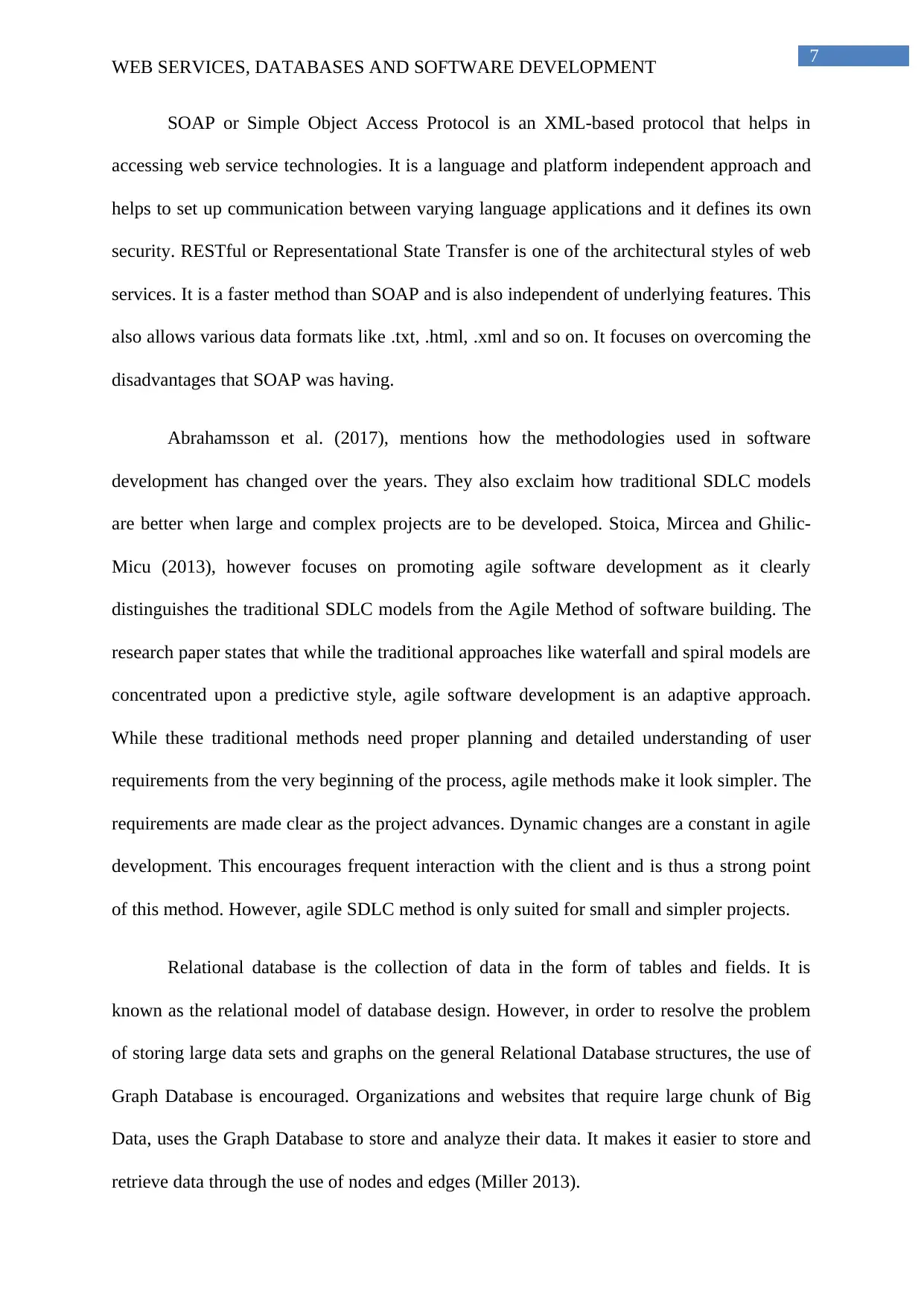
7
WEB SERVICES, DATABASES AND SOFTWARE DEVELOPMENT
SOAP or Simple Object Access Protocol is an XML-based protocol that helps in
accessing web service technologies. It is a language and platform independent approach and
helps to set up communication between varying language applications and it defines its own
security. RESTful or Representational State Transfer is one of the architectural styles of web
services. It is a faster method than SOAP and is also independent of underlying features. This
also allows various data formats like .txt, .html, .xml and so on. It focuses on overcoming the
disadvantages that SOAP was having.
Abrahamsson et al. (2017), mentions how the methodologies used in software
development has changed over the years. They also exclaim how traditional SDLC models
are better when large and complex projects are to be developed. Stoica, Mircea and Ghilic-
Micu (2013), however focuses on promoting agile software development as it clearly
distinguishes the traditional SDLC models from the Agile Method of software building. The
research paper states that while the traditional approaches like waterfall and spiral models are
concentrated upon a predictive style, agile software development is an adaptive approach.
While these traditional methods need proper planning and detailed understanding of user
requirements from the very beginning of the process, agile methods make it look simpler. The
requirements are made clear as the project advances. Dynamic changes are a constant in agile
development. This encourages frequent interaction with the client and is thus a strong point
of this method. However, agile SDLC method is only suited for small and simpler projects.
Relational database is the collection of data in the form of tables and fields. It is
known as the relational model of database design. However, in order to resolve the problem
of storing large data sets and graphs on the general Relational Database structures, the use of
Graph Database is encouraged. Organizations and websites that require large chunk of Big
Data, uses the Graph Database to store and analyze their data. It makes it easier to store and
retrieve data through the use of nodes and edges (Miller 2013).
WEB SERVICES, DATABASES AND SOFTWARE DEVELOPMENT
SOAP or Simple Object Access Protocol is an XML-based protocol that helps in
accessing web service technologies. It is a language and platform independent approach and
helps to set up communication between varying language applications and it defines its own
security. RESTful or Representational State Transfer is one of the architectural styles of web
services. It is a faster method than SOAP and is also independent of underlying features. This
also allows various data formats like .txt, .html, .xml and so on. It focuses on overcoming the
disadvantages that SOAP was having.
Abrahamsson et al. (2017), mentions how the methodologies used in software
development has changed over the years. They also exclaim how traditional SDLC models
are better when large and complex projects are to be developed. Stoica, Mircea and Ghilic-
Micu (2013), however focuses on promoting agile software development as it clearly
distinguishes the traditional SDLC models from the Agile Method of software building. The
research paper states that while the traditional approaches like waterfall and spiral models are
concentrated upon a predictive style, agile software development is an adaptive approach.
While these traditional methods need proper planning and detailed understanding of user
requirements from the very beginning of the process, agile methods make it look simpler. The
requirements are made clear as the project advances. Dynamic changes are a constant in agile
development. This encourages frequent interaction with the client and is thus a strong point
of this method. However, agile SDLC method is only suited for small and simpler projects.
Relational database is the collection of data in the form of tables and fields. It is
known as the relational model of database design. However, in order to resolve the problem
of storing large data sets and graphs on the general Relational Database structures, the use of
Graph Database is encouraged. Organizations and websites that require large chunk of Big
Data, uses the Graph Database to store and analyze their data. It makes it easier to store and
retrieve data through the use of nodes and edges (Miller 2013).
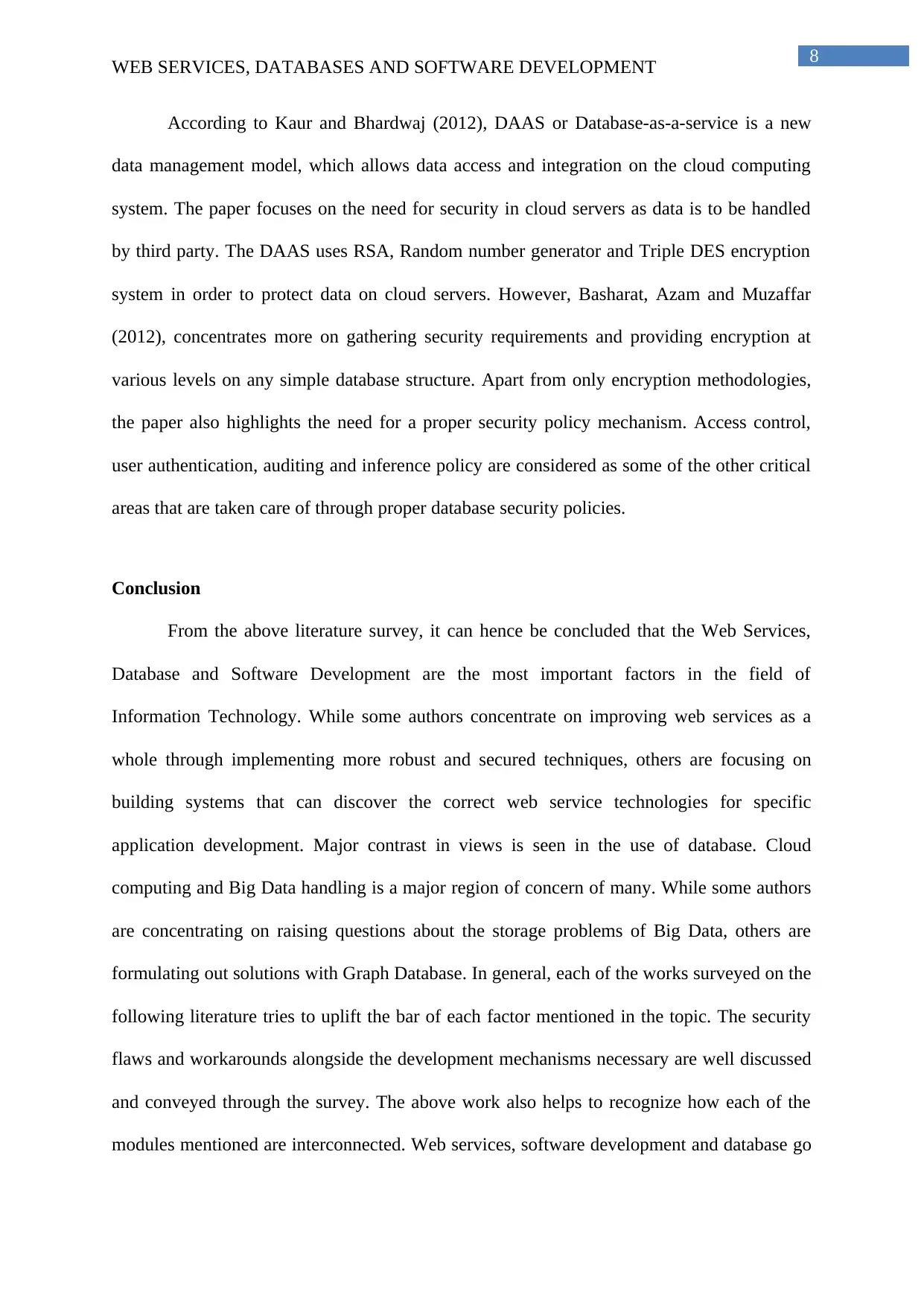
8
WEB SERVICES, DATABASES AND SOFTWARE DEVELOPMENT
According to Kaur and Bhardwaj (2012), DAAS or Database-as-a-service is a new
data management model, which allows data access and integration on the cloud computing
system. The paper focuses on the need for security in cloud servers as data is to be handled
by third party. The DAAS uses RSA, Random number generator and Triple DES encryption
system in order to protect data on cloud servers. However, Basharat, Azam and Muzaffar
(2012), concentrates more on gathering security requirements and providing encryption at
various levels on any simple database structure. Apart from only encryption methodologies,
the paper also highlights the need for a proper security policy mechanism. Access control,
user authentication, auditing and inference policy are considered as some of the other critical
areas that are taken care of through proper database security policies.
Conclusion
From the above literature survey, it can hence be concluded that the Web Services,
Database and Software Development are the most important factors in the field of
Information Technology. While some authors concentrate on improving web services as a
whole through implementing more robust and secured techniques, others are focusing on
building systems that can discover the correct web service technologies for specific
application development. Major contrast in views is seen in the use of database. Cloud
computing and Big Data handling is a major region of concern of many. While some authors
are concentrating on raising questions about the storage problems of Big Data, others are
formulating out solutions with Graph Database. In general, each of the works surveyed on the
following literature tries to uplift the bar of each factor mentioned in the topic. The security
flaws and workarounds alongside the development mechanisms necessary are well discussed
and conveyed through the survey. The above work also helps to recognize how each of the
modules mentioned are interconnected. Web services, software development and database go
WEB SERVICES, DATABASES AND SOFTWARE DEVELOPMENT
According to Kaur and Bhardwaj (2012), DAAS or Database-as-a-service is a new
data management model, which allows data access and integration on the cloud computing
system. The paper focuses on the need for security in cloud servers as data is to be handled
by third party. The DAAS uses RSA, Random number generator and Triple DES encryption
system in order to protect data on cloud servers. However, Basharat, Azam and Muzaffar
(2012), concentrates more on gathering security requirements and providing encryption at
various levels on any simple database structure. Apart from only encryption methodologies,
the paper also highlights the need for a proper security policy mechanism. Access control,
user authentication, auditing and inference policy are considered as some of the other critical
areas that are taken care of through proper database security policies.
Conclusion
From the above literature survey, it can hence be concluded that the Web Services,
Database and Software Development are the most important factors in the field of
Information Technology. While some authors concentrate on improving web services as a
whole through implementing more robust and secured techniques, others are focusing on
building systems that can discover the correct web service technologies for specific
application development. Major contrast in views is seen in the use of database. Cloud
computing and Big Data handling is a major region of concern of many. While some authors
are concentrating on raising questions about the storage problems of Big Data, others are
formulating out solutions with Graph Database. In general, each of the works surveyed on the
following literature tries to uplift the bar of each factor mentioned in the topic. The security
flaws and workarounds alongside the development mechanisms necessary are well discussed
and conveyed through the survey. The above work also helps to recognize how each of the
modules mentioned are interconnected. Web services, software development and database go
⊘ This is a preview!⊘
Do you want full access?
Subscribe today to unlock all pages.

Trusted by 1+ million students worldwide
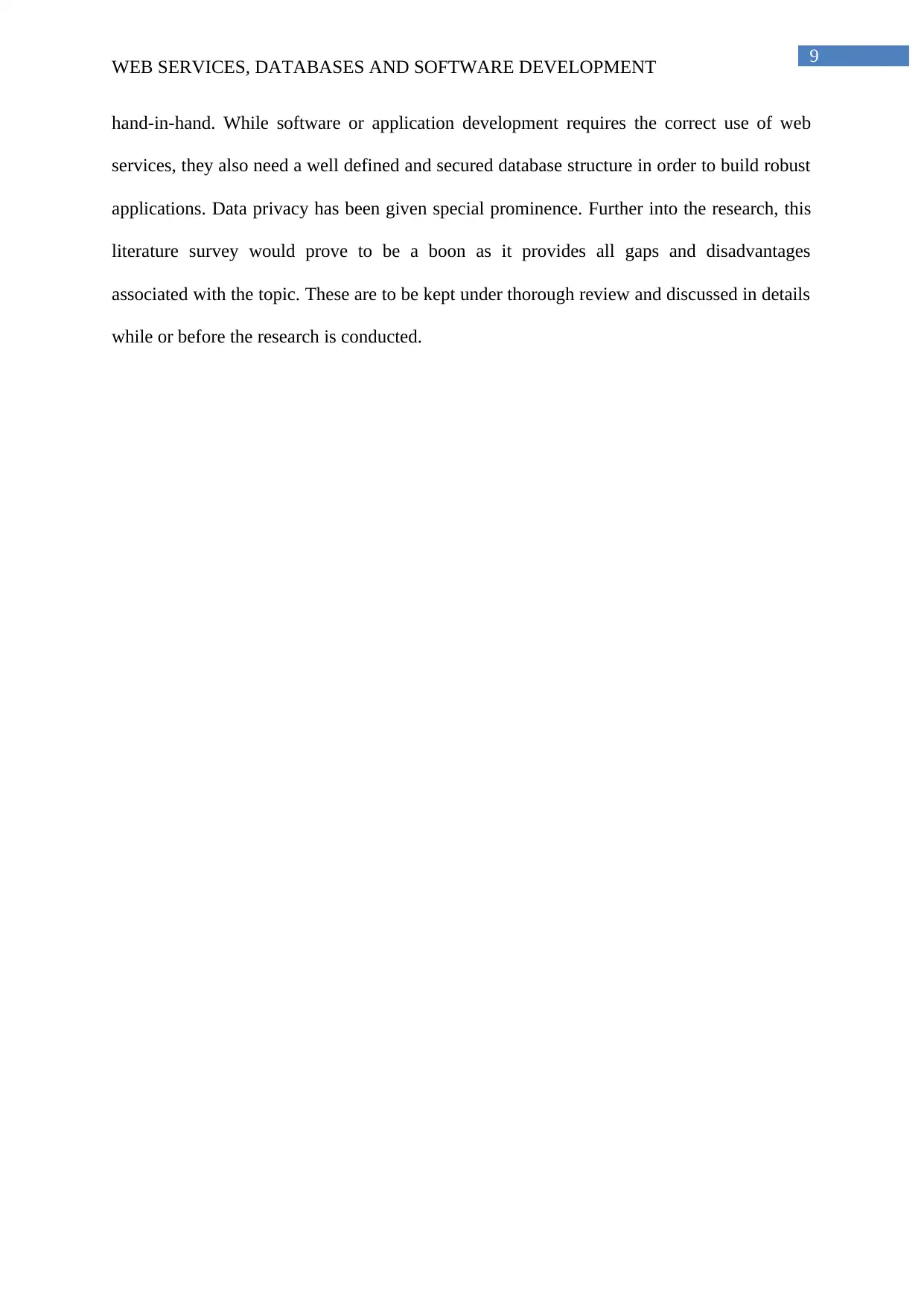
9
WEB SERVICES, DATABASES AND SOFTWARE DEVELOPMENT
hand-in-hand. While software or application development requires the correct use of web
services, they also need a well defined and secured database structure in order to build robust
applications. Data privacy has been given special prominence. Further into the research, this
literature survey would prove to be a boon as it provides all gaps and disadvantages
associated with the topic. These are to be kept under thorough review and discussed in details
while or before the research is conducted.
WEB SERVICES, DATABASES AND SOFTWARE DEVELOPMENT
hand-in-hand. While software or application development requires the correct use of web
services, they also need a well defined and secured database structure in order to build robust
applications. Data privacy has been given special prominence. Further into the research, this
literature survey would prove to be a boon as it provides all gaps and disadvantages
associated with the topic. These are to be kept under thorough review and discussed in details
while or before the research is conducted.
Paraphrase This Document
Need a fresh take? Get an instant paraphrase of this document with our AI Paraphraser
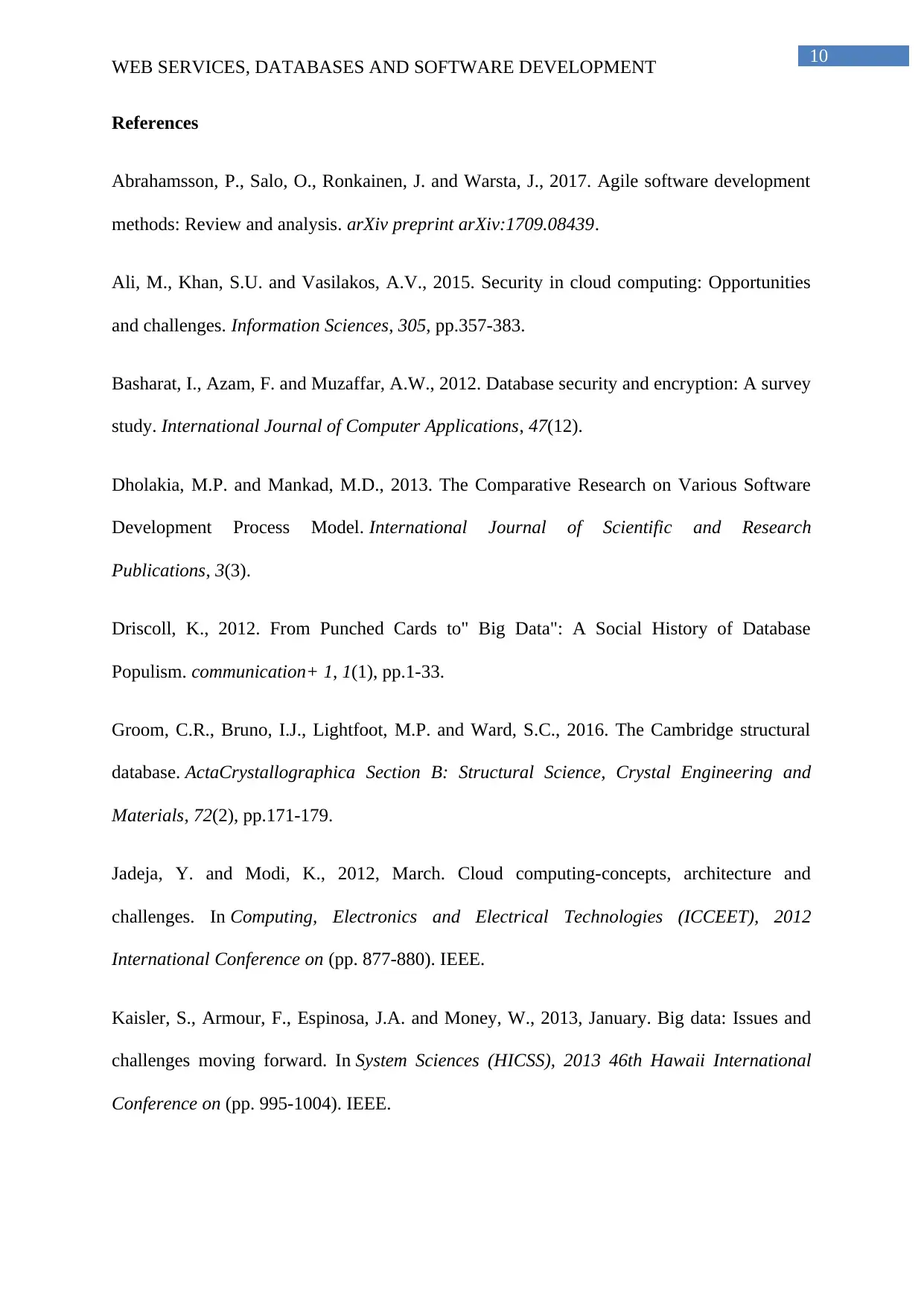
10
WEB SERVICES, DATABASES AND SOFTWARE DEVELOPMENT
References
Abrahamsson, P., Salo, O., Ronkainen, J. and Warsta, J., 2017. Agile software development
methods: Review and analysis. arXiv preprint arXiv:1709.08439.
Ali, M., Khan, S.U. and Vasilakos, A.V., 2015. Security in cloud computing: Opportunities
and challenges. Information Sciences, 305, pp.357-383.
Basharat, I., Azam, F. and Muzaffar, A.W., 2012. Database security and encryption: A survey
study. International Journal of Computer Applications, 47(12).
Dholakia, M.P. and Mankad, M.D., 2013. The Comparative Research on Various Software
Development Process Model. International Journal of Scientific and Research
Publications, 3(3).
Driscoll, K., 2012. From Punched Cards to" Big Data": A Social History of Database
Populism. communication+ 1, 1(1), pp.1-33.
Groom, C.R., Bruno, I.J., Lightfoot, M.P. and Ward, S.C., 2016. The Cambridge structural
database. ActaCrystallographica Section B: Structural Science, Crystal Engineering and
Materials, 72(2), pp.171-179.
Jadeja, Y. and Modi, K., 2012, March. Cloud computing-concepts, architecture and
challenges. In Computing, Electronics and Electrical Technologies (ICCEET), 2012
International Conference on (pp. 877-880). IEEE.
Kaisler, S., Armour, F., Espinosa, J.A. and Money, W., 2013, January. Big data: Issues and
challenges moving forward. In System Sciences (HICSS), 2013 46th Hawaii International
Conference on (pp. 995-1004). IEEE.
WEB SERVICES, DATABASES AND SOFTWARE DEVELOPMENT
References
Abrahamsson, P., Salo, O., Ronkainen, J. and Warsta, J., 2017. Agile software development
methods: Review and analysis. arXiv preprint arXiv:1709.08439.
Ali, M., Khan, S.U. and Vasilakos, A.V., 2015. Security in cloud computing: Opportunities
and challenges. Information Sciences, 305, pp.357-383.
Basharat, I., Azam, F. and Muzaffar, A.W., 2012. Database security and encryption: A survey
study. International Journal of Computer Applications, 47(12).
Dholakia, M.P. and Mankad, M.D., 2013. The Comparative Research on Various Software
Development Process Model. International Journal of Scientific and Research
Publications, 3(3).
Driscoll, K., 2012. From Punched Cards to" Big Data": A Social History of Database
Populism. communication+ 1, 1(1), pp.1-33.
Groom, C.R., Bruno, I.J., Lightfoot, M.P. and Ward, S.C., 2016. The Cambridge structural
database. ActaCrystallographica Section B: Structural Science, Crystal Engineering and
Materials, 72(2), pp.171-179.
Jadeja, Y. and Modi, K., 2012, March. Cloud computing-concepts, architecture and
challenges. In Computing, Electronics and Electrical Technologies (ICCEET), 2012
International Conference on (pp. 877-880). IEEE.
Kaisler, S., Armour, F., Espinosa, J.A. and Money, W., 2013, January. Big data: Issues and
challenges moving forward. In System Sciences (HICSS), 2013 46th Hawaii International
Conference on (pp. 995-1004). IEEE.
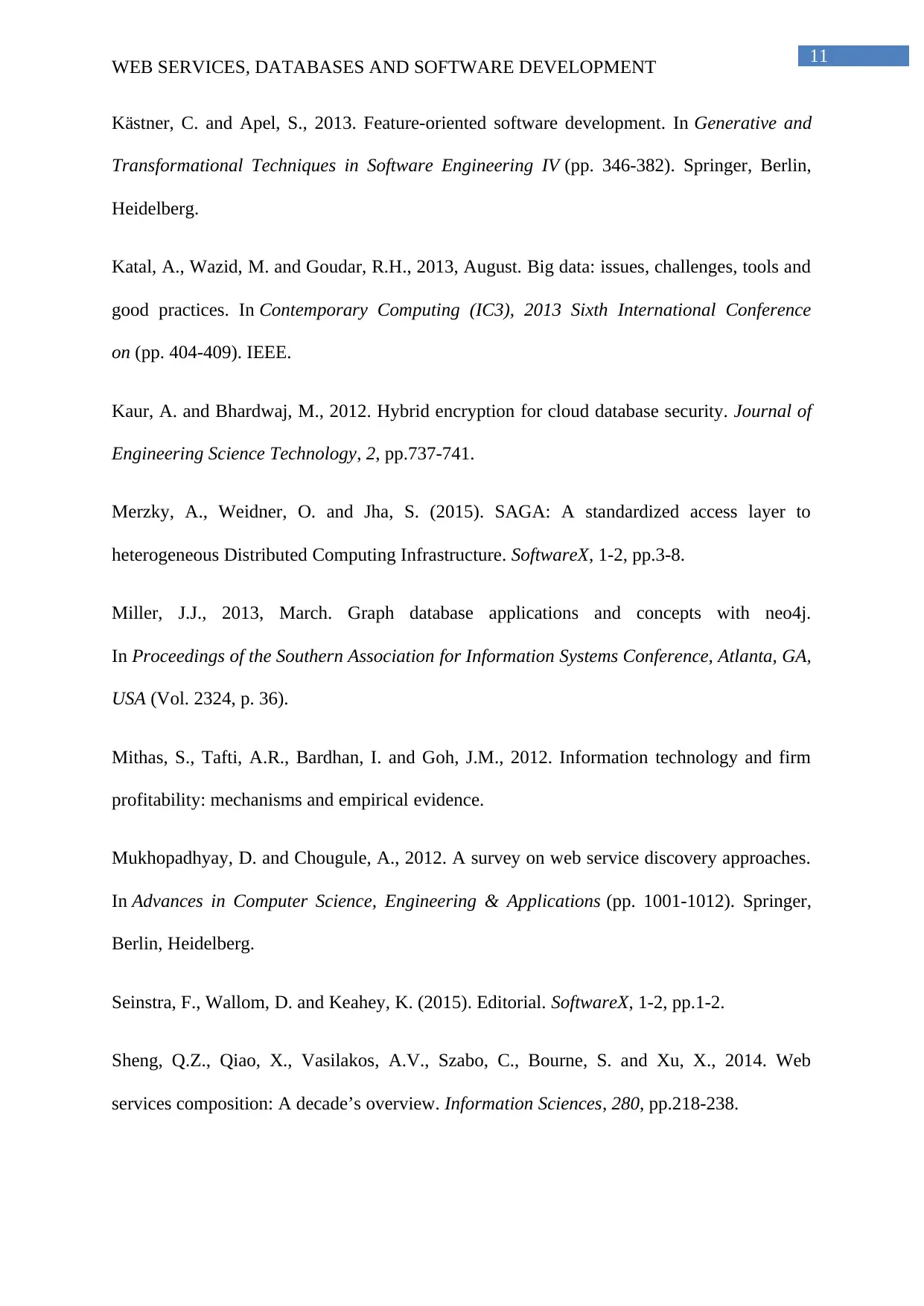
11
WEB SERVICES, DATABASES AND SOFTWARE DEVELOPMENT
Kästner, C. and Apel, S., 2013. Feature-oriented software development. In Generative and
Transformational Techniques in Software Engineering IV (pp. 346-382). Springer, Berlin,
Heidelberg.
Katal, A., Wazid, M. and Goudar, R.H., 2013, August. Big data: issues, challenges, tools and
good practices. In Contemporary Computing (IC3), 2013 Sixth International Conference
on (pp. 404-409). IEEE.
Kaur, A. and Bhardwaj, M., 2012. Hybrid encryption for cloud database security. Journal of
Engineering Science Technology, 2, pp.737-741.
Merzky, A., Weidner, O. and Jha, S. (2015). SAGA: A standardized access layer to
heterogeneous Distributed Computing Infrastructure. SoftwareX, 1-2, pp.3-8.
Miller, J.J., 2013, March. Graph database applications and concepts with neo4j.
In Proceedings of the Southern Association for Information Systems Conference, Atlanta, GA,
USA (Vol. 2324, p. 36).
Mithas, S., Tafti, A.R., Bardhan, I. and Goh, J.M., 2012. Information technology and firm
profitability: mechanisms and empirical evidence.
Mukhopadhyay, D. and Chougule, A., 2012. A survey on web service discovery approaches.
In Advances in Computer Science, Engineering & Applications (pp. 1001-1012). Springer,
Berlin, Heidelberg.
Seinstra, F., Wallom, D. and Keahey, K. (2015). Editorial. SoftwareX, 1-2, pp.1-2.
Sheng, Q.Z., Qiao, X., Vasilakos, A.V., Szabo, C., Bourne, S. and Xu, X., 2014. Web
services composition: A decade’s overview. Information Sciences, 280, pp.218-238.
WEB SERVICES, DATABASES AND SOFTWARE DEVELOPMENT
Kästner, C. and Apel, S., 2013. Feature-oriented software development. In Generative and
Transformational Techniques in Software Engineering IV (pp. 346-382). Springer, Berlin,
Heidelberg.
Katal, A., Wazid, M. and Goudar, R.H., 2013, August. Big data: issues, challenges, tools and
good practices. In Contemporary Computing (IC3), 2013 Sixth International Conference
on (pp. 404-409). IEEE.
Kaur, A. and Bhardwaj, M., 2012. Hybrid encryption for cloud database security. Journal of
Engineering Science Technology, 2, pp.737-741.
Merzky, A., Weidner, O. and Jha, S. (2015). SAGA: A standardized access layer to
heterogeneous Distributed Computing Infrastructure. SoftwareX, 1-2, pp.3-8.
Miller, J.J., 2013, March. Graph database applications and concepts with neo4j.
In Proceedings of the Southern Association for Information Systems Conference, Atlanta, GA,
USA (Vol. 2324, p. 36).
Mithas, S., Tafti, A.R., Bardhan, I. and Goh, J.M., 2012. Information technology and firm
profitability: mechanisms and empirical evidence.
Mukhopadhyay, D. and Chougule, A., 2012. A survey on web service discovery approaches.
In Advances in Computer Science, Engineering & Applications (pp. 1001-1012). Springer,
Berlin, Heidelberg.
Seinstra, F., Wallom, D. and Keahey, K. (2015). Editorial. SoftwareX, 1-2, pp.1-2.
Sheng, Q.Z., Qiao, X., Vasilakos, A.V., Szabo, C., Bourne, S. and Xu, X., 2014. Web
services composition: A decade’s overview. Information Sciences, 280, pp.218-238.
⊘ This is a preview!⊘
Do you want full access?
Subscribe today to unlock all pages.

Trusted by 1+ million students worldwide
1 out of 13
Related Documents
Your All-in-One AI-Powered Toolkit for Academic Success.
+13062052269
info@desklib.com
Available 24*7 on WhatsApp / Email
![[object Object]](/_next/static/media/star-bottom.7253800d.svg)
Unlock your academic potential
Copyright © 2020–2025 A2Z Services. All Rights Reserved. Developed and managed by ZUCOL.





